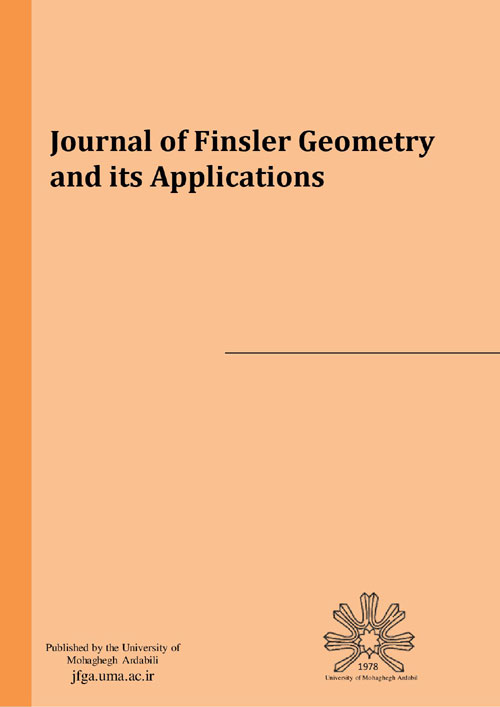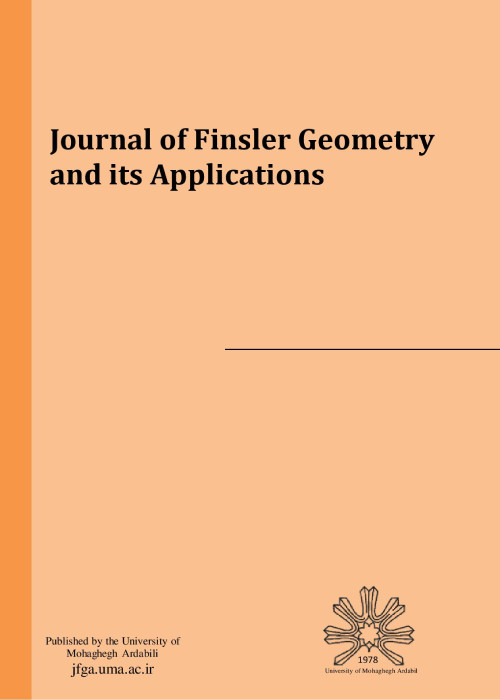فهرست مطالب

Journal of Finsler Geometry and its Applications
Volume:3 Issue: 1, Aug 2022
- تاریخ انتشار: 1401/05/22
- تعداد عناوین: 12
-
-
Pages 1-15In this paper, we establish first order gradient estimates for positive global solutions of the heat equation under closed Finsler-Ricci flow with weighted Ricci curvature RicN bounded below, where N∈ (n,∞). As an application, we derive the corresponding Harnack inequality. Our results are the generalizations and the supplements of the previous known related results.Keywords: Finsler-Ricci flow, gradient estimate, heat equation, weighted Ricci curvature, Ricci curvature tensor
-
Pages 16-30In this paper we characterize a minimal surface with Matsumoto metric and prove a Bernstein-type theorem for surfaces which are graphs of smooth functions. We also obtain the partial differential equation that characterizes the minimal translation surfaces and show that plane is the only such surface.Keywords: Finsler spaces, Matsumoto metric, Minimal surfaces, Graph of a function, Surface of translation
-
Pages 31-41In this paper, we have defined the concept of the R-complex Finsler space with an arctangent (α, β)-metric F = α + ε β + β tan-1( β / α). For this metric, we have obtained the fundamental metric tensor fields gijand gi¯j as well as their determinants and inverse tensor fields. Further, some properties of non-Hermitian R-complex Finsler spaces with this metric have been described.Keywords: Complex Finsler space, $mathbb{R} $-complex Finsler space, Fundamental metric tensors
-
Pages 42-48Recently, the relationship between (geodesics) convexity, connectedness, and completeness properties in Riemannian manifolds (∑; h) and the causal properties in Lorentzian static spacetimes (M; g) = (R × ∑; -dt2 + h) is studied. In this paper, some sufficient conditions are introduced to (∑; h) be geodesically convex.Keywords: Spacetimes, Causal structure, Pseudoconvexity, Convexity
-
Pages 49-65The investigation of rotating fluids in the context of general relativity received remarkable consideration principally after Godel proposed relativistic model of a rotating dust universe. In this paper, a comprehensive analysis regarding the structure of the Lie algebra of Killing vector fields for a specific solution of field equations describing the behavior of rotating fluid models is presented. Killing vector fields can be undoubtedly reckoned as one of the most substantial types of symmetries and are denoted by the smooth vector fields which preserve the metric tensor. In this paper, we specifically concentrate on detailed investigation of the Killing vector fields by reexpressing the analyzed cosmological solution in the orthogonal frame. Significantly, for the resulted Lie algebra of Killing vector fields, the associated basis for the original Lie algebra is determined in which the Lie algebra will be appropriately decomposed into an internal direct sum of subalgebras, where each summand is indecomposable. Ultimately, the preliminary group classification of the symmetry algebra of the killing vector fields is presented. This noteworthy objective is thoroughly fulfilled via constructing the adjoint representation group, which generically insinuates a conjugate relation in the set of all one-dimensional subalgebras. Consequently, the corresponding set of invariant solutions can be reckoned canonically as the mimimal list from which all the other invariant solutions of one-dimensional subalgebras are comprehensively designated unambiguously by virtue of transformations.Keywords: Killing vector fields, Five Dimensional Spacetime, Rotating Fluids, Orthogonal Frame, Adjoint Representation
-
Pages 66-71In this paper, we use the mean curvature flow PDE and geodesic ODE to smooth and trace evolving curves as boundaries of minimal surfaces for a gray-scale image to capture their boundaries.Keywords: Geodesic, image processing, minimal surface, mean curvature, Riemannian metric
-
Pages 72-85The constrained mechanical systems in velocity component are known as nonholonomic constraints which are significantly important in engineering and robotics. A number of applicable theoretical studies have been performed on such systems among which the geometrical approach for mechanical systems has received extensive consideration. The movement direction, dynamical stability, and system control are among the topics geometrically related to mechanical (nonholonomic) systems. In this paper, a review of the geometrical point of view of mechanical systems constrained bynonholonomic constraints is represented. Moreover, we aim to find the motion equation of a ballistic missile moving towards a given target in a three-dimensional space. Initially, we calculate the motion equation of a ballistic missile which is launched towards an object moving along the z-axis with a constant velocity c. Finally, a general condition is assumed and the motion equation of the missile chasing a moving object in a R3 space along a certain curve defined by the parametrical equations x =ξ(t), y = η(t) and z = ζ(t) is calculated.Keywords: Lagrangian system, constraints, constrained nonholonomic system
-
Pages 86-99In this paper, we introduce two classes of stretch Finsler metrics. A Finsler metric with vanishing stretch B∼-curvature ( stretch H-curvature) is called B∼-stretch (H-stretch) metric (respectively). The class of B∼-stretch (H-stretch) metric contain the class of Berwald (weakly Berwald) metric (respectively). First, we show that every complete B∼-stretch metric (H-stretch metric) is a B∼-metric (H-metric). Then we prove that every compact Finsler manifold with non-negative (non-positive) relatively isotropic stretch B∼-curvature (stretch H-curvature) is B∼-metric (H-metric).Keywords: stretch curvature, complete stretch metric, Berwald curvature, $ textbf{H} $-curvature, relatively isotropic stretch curvature
-
Pages 100-117We provide an extension of Obata's theorem to Finsler geometry and establish some rigidity results based on a second-order differential equation. Mainly, we prove that every complete simply connected Finsler manifold of positive constant flag curvature is isometrically homeomorphic to a Euclidean sphere endowed with a certain Finsler metric and vice versa. Based on these results, we present a classification of Finsler manifolds which admit a transnormal function. Specifically, we show that if a complete Finsler manifold admits a transnormal function with exactly two critical points, then it is homeomorphic to a sphere.Keywords: Finsler metric, Rigidity, Constant curvature, Second-order differential equation, Adapted coordinate
-
Pages 118-126
In this paper, we introduce the notion of sympathetic hom-Lie superalgebras. We prove some results on sympathetic multiplicative hom-Lie superalgebras with surjective α. In particular, we find some equivalence condition in which a sympathetic graded hom-ideal is direct factor of multiplicative hom-Lie superalgebra.
Keywords: hom-Lie superalgebra, sympathetic hom-Lie superalgebra, multiplicative hom-Lie superalgebra -
Pages 127-140Using the action of a Lie group on a hypergroup, the notion of Lie hypergroup is defined. It is proved that tangent space of a Lie hypergroup is a hypergroup and that a differentiable map between two Lie hypergroup is good homomorphism if and only if its differential map is a good homomorphism. The action of a hypergroup on a set is defined. Using this notion, hypergroup bundle is introduced and some of its basic properties are investigated. In addition, some results on qutient hypergroups are given.Keywords: Hypergroup, Action, Quotient Space, Sub Hypergroup, Hypergroup Bundle
-
Pages 141-154In this paper, we first study a special class of (α,β)-metrics in the form F = α + εβ + k β2/α , where α is Riemannian metric, β is a 1-form, and ε,k(≠ 0) are constant. We give a complete classification for such metrics to be locally dually flat. By assumption β is a conformal 1-form, we show that the metric is locally dually flat if and only if α is a Euclidean metric and β is a constant 1-form. Further, we classify locally dually flat of a class of Finsler metric in the form F = α exp( α/β ) + εβ, where ε is constant.Keywords: Finsler metric, (α, β)- metric, locally dually flat


